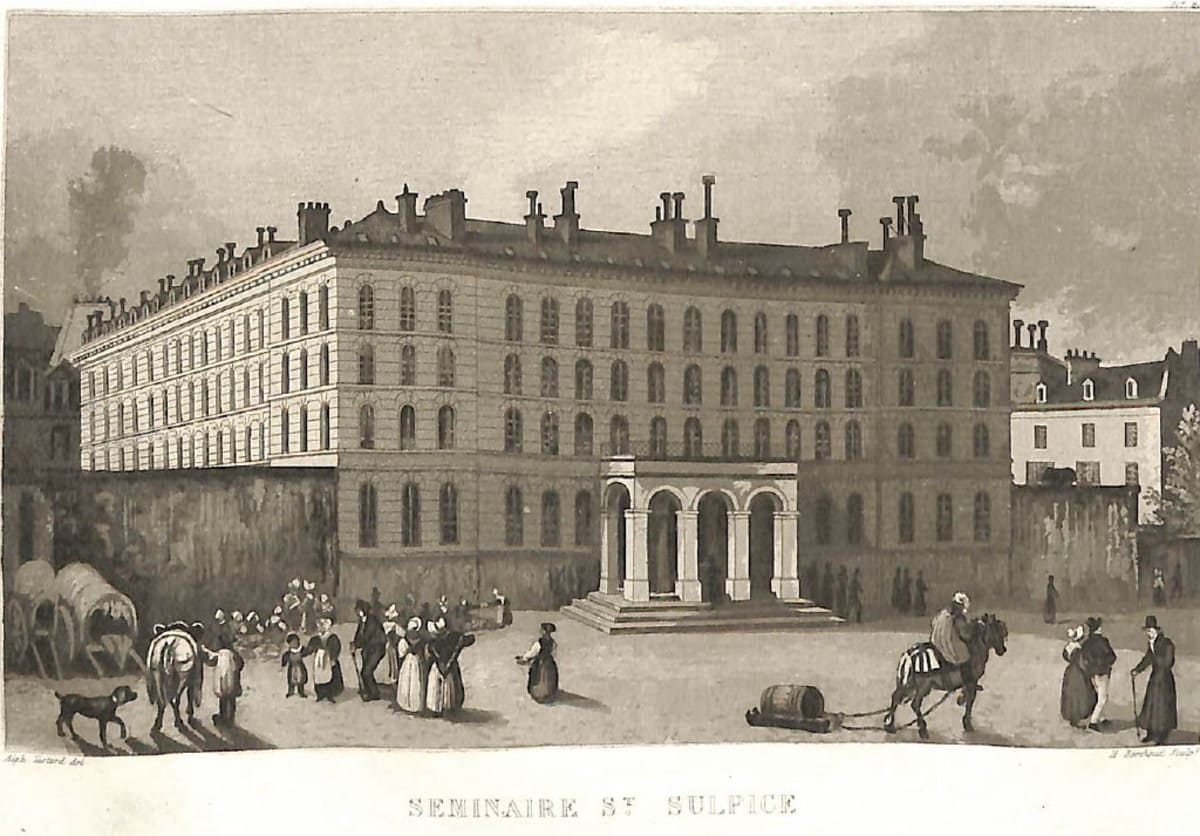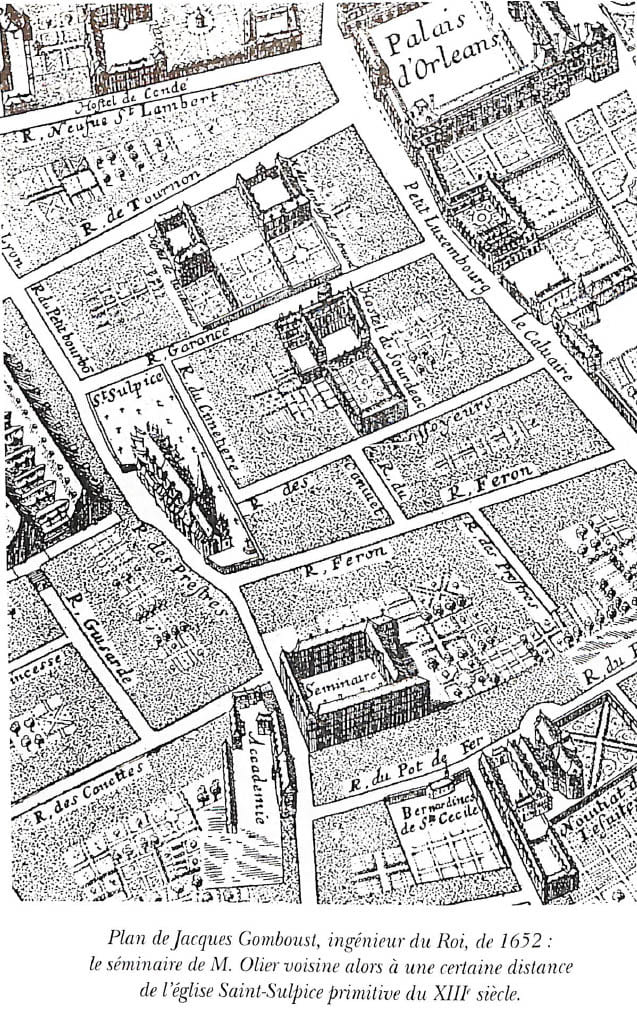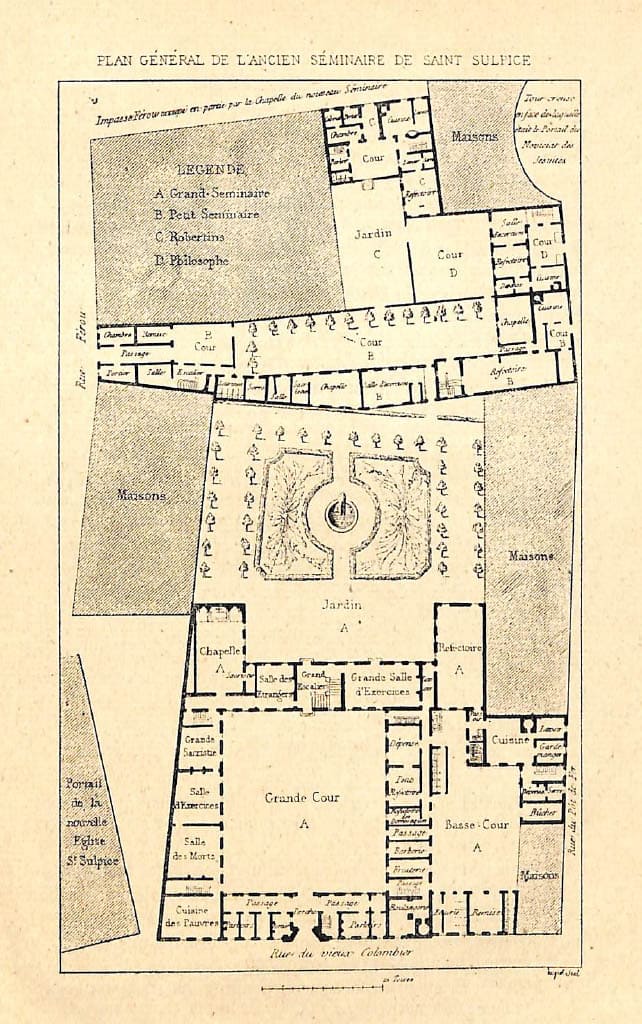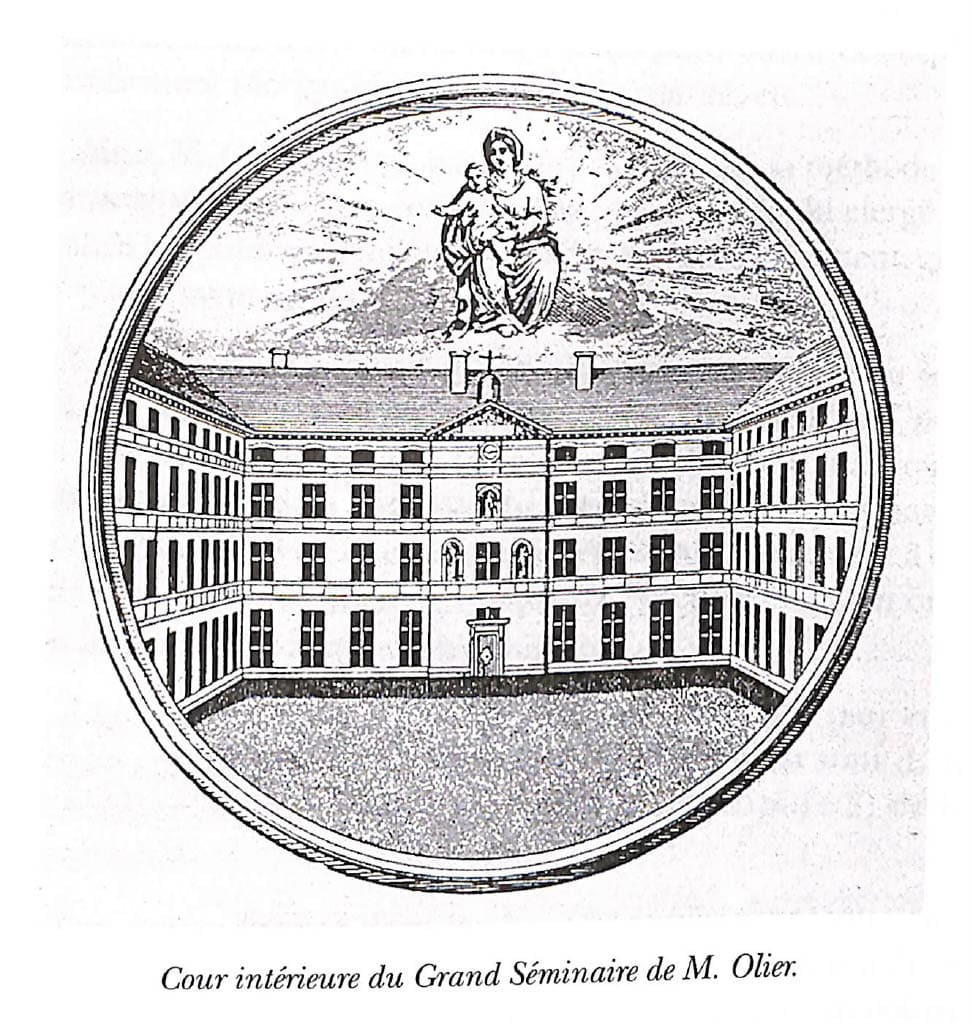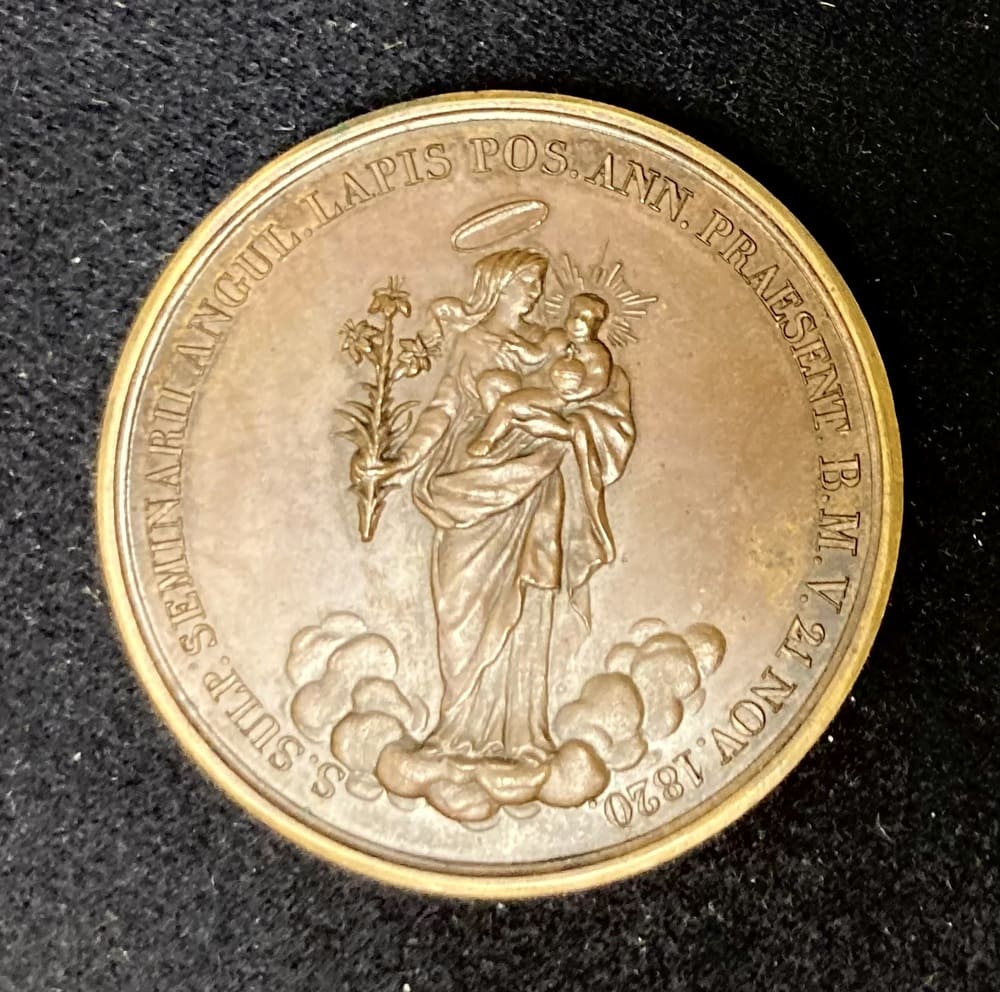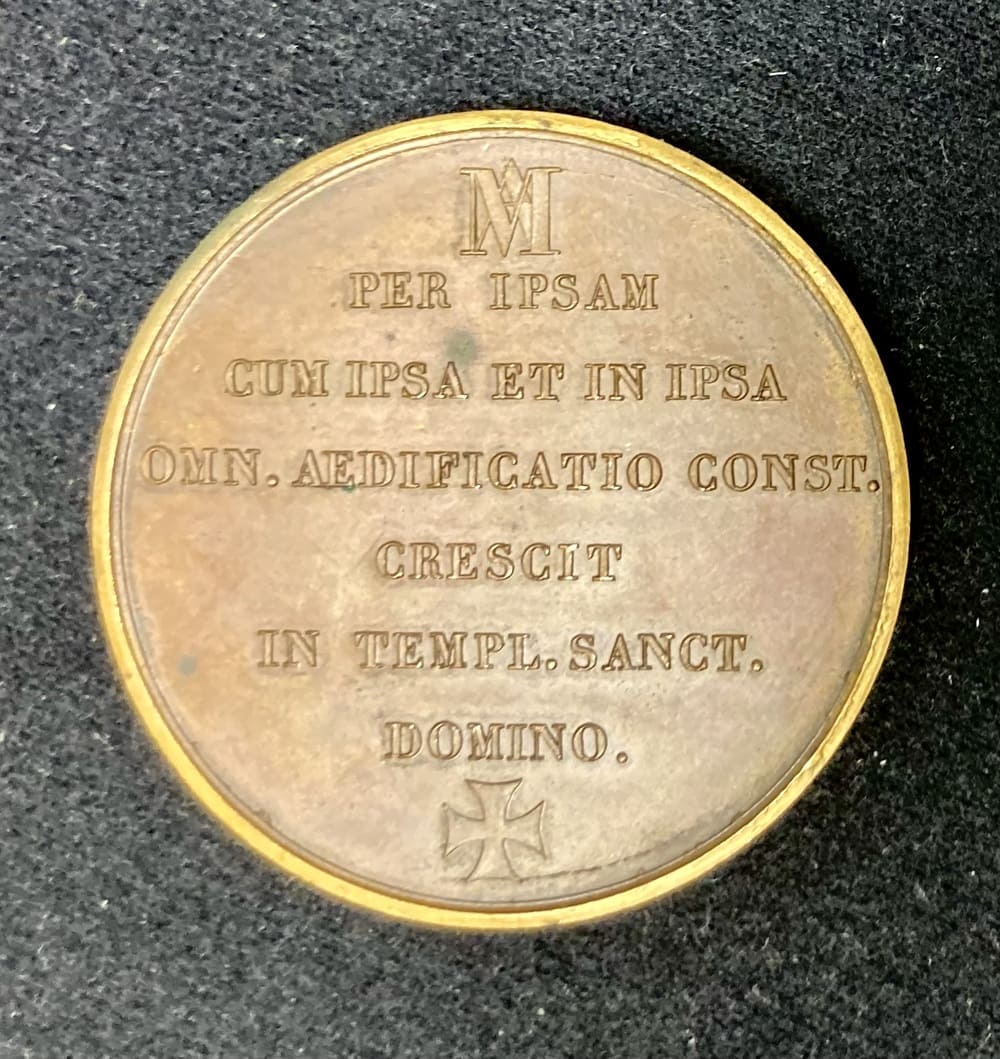The Seminary of Saint Sulpice, which today is identified with the magnificent building at 33 rue du Général Leclerc in Issy-les-Moulineaux, was not always found at this address. While it is quite natural to identify an institution with the place where its activity is carried out, it should be remembered that an institution can also relocate elsewhere through historical circumstances.
The construction of the Seminary of Saint Sulpice began in May 1645 after Jean-Jacques Olier, then the parish priest at the church of the same name, acquired a large piece of land bought from Mr. Blaise Méliand, then Attorney General of the Parliament of Paris. This land was located at rue du Vieux-Colombier, exactly opposite the old Church of Saint Sulpice. *
This is the property where Father Olier would build his seminary between 1648 and 1650, during the Regency of Queen Anne of Austria. It was done according to the plans of Jacques Le Mercier (1585-1654), who had been appointed the main architect to the king in the time of Louis XIII. The pastor of Saint Sulpice could then count on the generosity of Alexandre Le Ragois de Bretonvilliers, who joined the Society in 1643. He was the one who supported the construction of the seminary with his own funds throughout the entire project.
On the side of Vieux-Colombier Street, the entrance of the seminary held an inscription above it with the Latin expression “Spes messis in semine” (‘The hope of the harvest is in the seed’). It signified that the harvest was contained in the sowing of the seed. Jean-Jacques Olier indicated by this skillful play on words centered on the term semine (seed) what the purpose of this building would be, namely, housing seminarians and clerics during their formation for the priesthood.
The building was organized in a vast quadrilateral shape made up of three floors which overlooked a ground floor. Each floor, equipped with a passageway, or interior circulation gallery, gave access to different rooms. On the ground floor were large rooms for the spiritual exercises of the ordinands, as well as stairwells distributed in the different wings of the building. From the inner courtyard, entirely paved with sandstone, the entrance to the large chapel was recognizable by the pediment which contrasted sharply with the architectural sobriety of the rest of the building. On the tympanum of the chapel’s pediment was the following inscription: “Fundavit eam Altissimus” (‘The Most High founded it’). Under the pediment was nestled a statue of the Virgin holding her Son, standing on her knees. The Child Jesus holds in his hand a crown which he is about to place on the head of his Mother. This statuary, requested by Father Olier, had no other purpose than to honor the spiritual royalty of Mary whom he had made the patron saint of the Society and a model of selfless sacrifice for priests. On either side of the great door of the chapel appeared a statue of Saint Joseph, a fleur-de-lis in his hand, and a statue of Saint John the Evangelist, an eagle at his feet, a symbol which is traditionally attributed to him from the book of Revelation (4:7) and the prophet Ezekiel (1:10). These representations of Saint Joseph and Saint John referred to the secondary patrons of the Society, one as a symbol of protection, and the other as an image of spiritual childhood, as we can see in the foundational text, Pietas seminarii sancti sulpitii:
IX
Although the Most Blessed Sacrament is the memorial of all the marvels of Christ and makes their interior constantly present to us, the community will nevertheless attach itself with a tender predilection to the mysteries of the childhood of the Savior Jesus. It will strive to feed on his life, his dispositions and his spirit, mainly his spirit of humility and simplicity. It is towards him that the community will always turn its open mouth, in order to really desire with simplicity this very sweet milk, as newborn children do (1 Pet 2:2). The community will never forget this sentence: “If you do not become like this little child, you will not inherit the kingdom of heaven (Matt 18:3-4).
X
Since they adhere intimately to the Christ Child, the aspirants of this Society will honor with particular praise his Most Holy Mother Mary and blessed Joseph. They will abandon themselves fully and confidently to their guiding protection. As little children in Christ, they will pass their lives in complete safety, under the shadow of the wings of this father and mother, and they will be subject to them by means of perpetual servitude.
XI
They will also invoke as their particular patron Blessed John the Evangelist, who at the Last Supper became another Christ, and at the Cross the adopted son of his Mother. Venerating above all in his person the grace of the Eucharist, they will strive unceasingly to draw from his example this same grace from the source which flows from the side of the Lord.
In 1654, Father Olier obtained from Charles Le Brun, the future portrait artist of Louis XIV, an agreement to decorate the seminary chapel. The Seminary of Saint Sulpice would thus be the setting for two major works of Le Brun: The Triumph of the Virgin, which adorned the chapel ceiling, and Pentecost, which was placed above the high altar.
 The Triumph of the Virgin by Charles Lebrun, which ornamented the ceiling of the old seminary destroyed during the period of the Consulate in 1803
The Triumph of the Virgin by Charles Lebrun, which ornamented the ceiling of the old seminary destroyed during the period of the Consulate in 1803
It was in the middle of the 18th century that the seminary built by Father Olier began to be threatened by an urban planning project, following the work to enlarge the Church of Saint Sulpice. This work had resumed in 1719 under the Regency of the Duke of Orléans during the minority of Louis XV. The resumption of the expansion of the parish church, suspended since 1678, is commemorated by the medal that we can admire below. Indeed, the construction of the current façade had considerably projected the new parish building forward. The wall closest to the seminary was then less than 10 meters away from the north tower of the Church of Saint Sulpice, completely obscuring the new monumental façade by Mr. G. N. Servandoni.
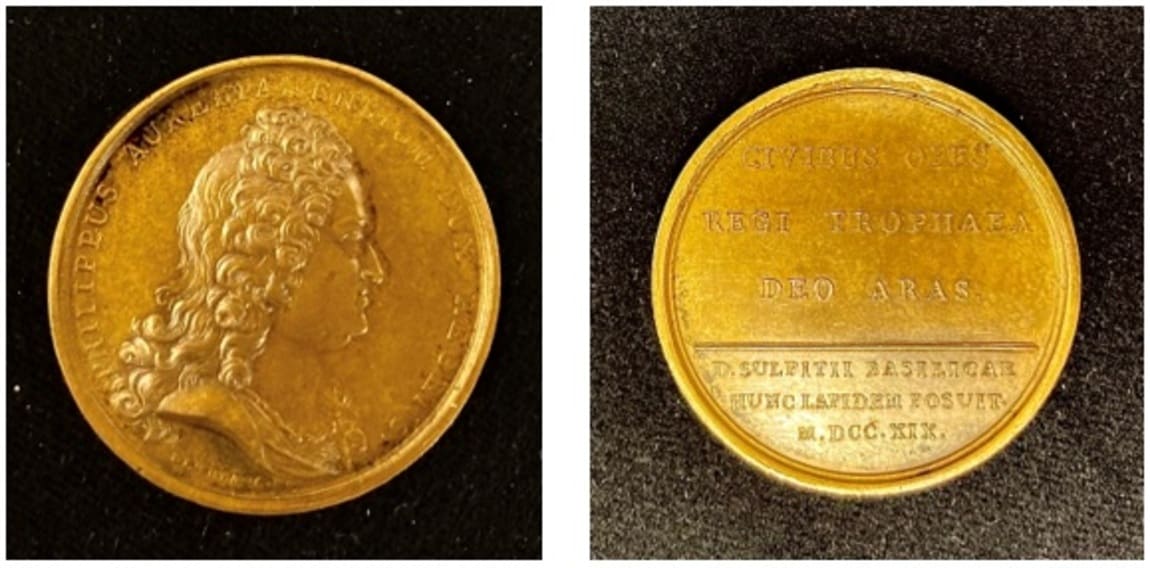 Front and back of the medal commemorating the resumption of work on the Church of Saint Sulpice (1719)
Front and back of the medal commemorating the resumption of work on the Church of Saint Sulpice (1719)
While the Revolution of 1789 was eventually to prevent the last achievements of the parish church (the pinnacles, completion of the south tower, and the pediment), the decision to demolish the Major Seminary wanted by Olier came from the First Consul Napoleon Bonaparte on October 9, 1802, via the Council of State. The building and its chapel would be demolished in February-March 1803, and this is how one of Charles Le Brun's major works called the Triumph of the Virgin would disappear. The painting of Pentecost that Father Olier had commissioned from Le Brun also disappeared from circulation. The Sulpicians would find it in Rome in 1843 during the auction of the works of the late Cardinal Fesch, a great collector and art lover. They managed to buy it back to reinstall it in the chapel of their new seminary, the reconstruction of which took place from 1820 to 1838.
It was therefore in 1820, on November 21, the feast day of the Sulpicians, that the first stone was laid for the new Seminary of Saint Sulpice, under the Rectorship of Antoine du Pouget Duclaux. It was decided to rebuild it on the southern slope of the current Place de Saint-Sulpice, a square whose development had been made possible by the demolition of the old seminary.
The restoration of the monarchy with the coming to power of Louis XVIII, King of France and Navarre from 1815, enabled the Society of Saint Sulpice to recover its legal existence from 1816, after it had been dissolved by Napoleon Bonaparte in 1811.
The reconstruction of the Seminary of Saint Sulpice, commemorated by a series of medals struck for the occasion, was therefore part of a policy of rehabilitation of the Christian religion according to the old alliance between the Throne and the Altar in France. It is for this reason that these medals were struck with the effigy of King Louis XVIII and Pope Pius VII.
Today, you can still admire this building which was confiscated by the French government in 1906, in application of the French law of separation of church and state. A decree of November 27, 1920 assigned the building to the Ministry of Finance. A historical plaque installed in front of the building reminds passers-by that the place once belonged to the Priests of Saint Sulpice.
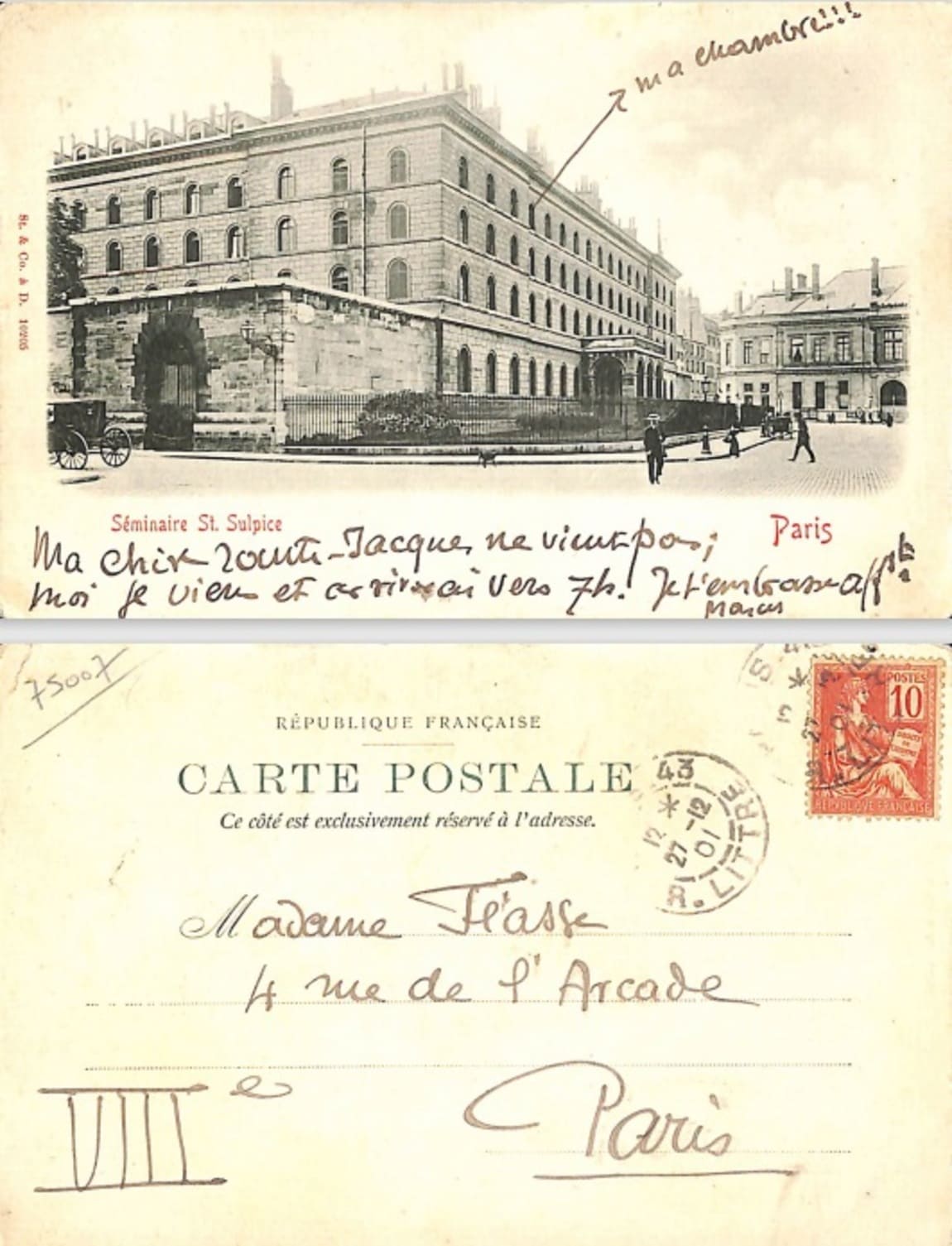 Postcard from a former seminarian, sent on December 27, 1901
Postcard from a former seminarian, sent on December 27, 1901
Mr. Zakaria HILAL, Archivist of the Society of the Priests of Saint Sulpice (Paris)
Translated by Ronald D. Witherup, P.S.S.



